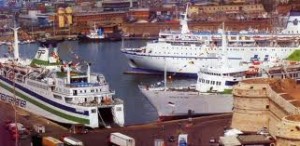History Port of Civitavecchia
 The Harbour Authority realizes great infrastructural works and not only guarantees the increase of the traffics heading for the development of the port of call but of the economy of the entire territory.
The Harbour Authority realizes great infrastructural works and not only guarantees the increase of the traffics heading for the development of the port of call but of the economy of the entire territory.
The port of Civitavecchia was founded by Emperor Trajan in 106 AD and planned by architect Apollodoro from Damascus.
It had a semi-circular pool of 500 meters circa and two big piers 400 meters long where two twin towers stood, the towers of Bicchiere and the Lazzaretto.
At the beginning of the port an artificial island would delimitate the harbor, where the lighthouse in 1616 and the Gregory fortress in 1800 were built.
In 1660 Bernini built an arsenal 50 meters long and with 6 big arches, destroyed by the bombings in WWII.
At the entrance of the harbor you find the Michelangelo Fortress, built upon the ancient roman maritime headquarter
Pope Julius II wanted the Michelangelo Fortress to be built in 1508 and it is the best kept monument in the port.
It was planned by Donato Bramante with the assistance of Antonio Da Sangallo. Te fortress was finished in 1537 with the supervision of Michelangelo.
The castle has a rectangular structure with four towers. Nowadays it is used to host exhibitions and events
Within the port, along the harbour walls built in 1600 by Pope Urban VIII, stand the Fountain of Vanvitelli (1743).
You can still see the remaining of Porta Livorno, one of the old port gates, built in 1761 by Pope Clemens XIII to let all port workers access the harbour quick and easily.
Continuando la nostra strada è possibile entrare, attraverso il varco degli antichi horrea, nella darsena romana.
If you keep on walking further, it is possible to see the ancient horrea. This building from the roman times has been perfectly kept until the Middle Age.
Today the harbour is the most important business in town. It offers good connections to Sardinia, Sicily, Barcelona, Tunis, Toulon, Malta and Corsica.
Thanks to the cruise ships landing here, Civitavecchia (The heart of Italy) has become the second port in Europe.



















